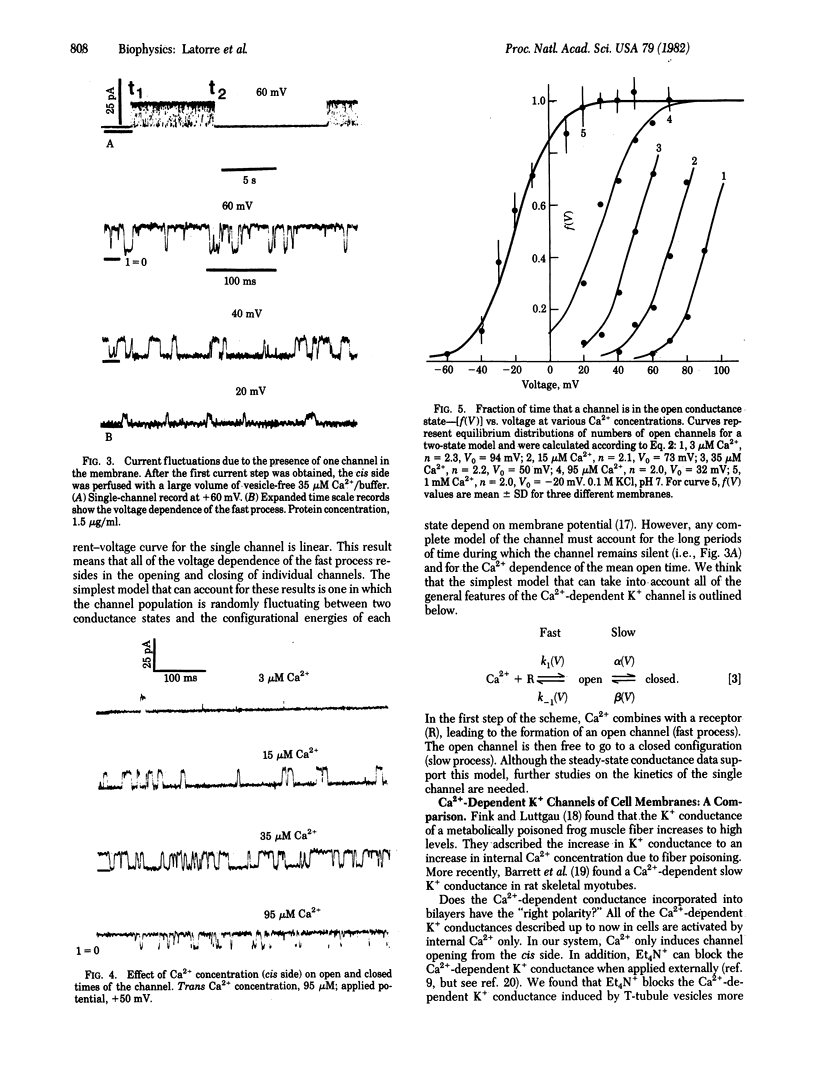Abstract
Addition of membrane vesicles prepared from transverse tubule (T-tubule) membranes of rabbit skeletal muscle to the aqueous phase of a planar lipid bilayer induces a stepwise increase in conductance. This conductance is both voltage and Ca2+ dependent. At 1 mM Ca2+, the steady-state conductance is maximal at voltages higher than +20 mV and decreases for more negative voltages. (Voltages refer to the side to which the vesicles are added, cis) Decreasing the Ca2+ concentration reversibly shifts the conductance-voltage curve toward the right along the voltage axis. Furthermore, Ca2+ can activate the conductance only if added to the cis compartment. Neither Mg2+, Ba2+, nor Cd2+ can activate the conductance induced by T-tubule vesicles. Addition of 5 mM tetraethylammonium ion to the trans, but not the cis, side abolishes the T-tubule-induced conductance. The Ca2+-dependent conductance appears as a consequence of ionic channel formation. Single-channel activity appears in bursts followed by periods of time in which the channel remains "silent". The conductance of the open channel averages 226 pS in 0.1 M KC1 and is voltage and Ca2+ independent. However, the fraction of time that the channel remains in the open state is voltage and Ca2+ dependent in a manner that parallels the voltage and Ca2+ dependence of the multichannel membrane. The channel is 6.6 times more permeable to K+ than to Na+ and is impermeable to C1-.
Full text
PDF




Selected References
These references are in PubMed. This may not be the complete list of references from this article.
- Adrian R. H., Chandler W. K., Hodgkin A. L. Slow changes in potassium permeability in skeletal muscle. J Physiol. 1970 Jul;208(3):645–668. doi: 10.1113/jphysiol.1970.sp009140. [DOI] [PMC free article] [PubMed] [Google Scholar]
- Barrett J. N., Barrett E. F., Dribin L. B. Calcium-dependent slow potassium conductance in rat skeletal myotubes. Dev Biol. 1981 Mar;82(2):258–266. doi: 10.1016/0012-1606(81)90450-4. [DOI] [PubMed] [Google Scholar]
- Cohen F. S., Zimmerberg J., Finkelstein A. Fusion of phospholipid vesicles with planar phospholipid bilayer membranes. II. Incorporation of a vesicular membrane marker into the planar membrane. J Gen Physiol. 1980 Mar;75(3):251–270. doi: 10.1085/jgp.75.3.251. [DOI] [PMC free article] [PubMed] [Google Scholar]
- Ehrenstein G., Blumenthal R., Latorre R., Lecar H. Kinetics of the opening and closing of individual excitability-inducing material channels in a lipid bilayer. J Gen Physiol. 1974 Jun;63(6):707–721. doi: 10.1085/jgp.63.6.707. [DOI] [PMC free article] [PubMed] [Google Scholar]
- Ehrenstein G., Lecar H., Nossal R. The nature of the negative resistance in bimolecular lipid membranes containing excitability-inducing material. J Gen Physiol. 1970 Jan;55(1):119–133. doi: 10.1085/jgp.55.1.119. [DOI] [PMC free article] [PubMed] [Google Scholar]
- Fink R., Lüttgau H. C. An evaluation of the membrane constants and the potassium conductance in metabolically exhausted muscle fibres. J Physiol. 1976 Dec;263(2):215–238. doi: 10.1113/jphysiol.1976.sp011629. [DOI] [PMC free article] [PubMed] [Google Scholar]
- González-Serratos H. Inward spread of activation in vertebrate muscle fibres. J Physiol. 1971 Feb;212(3):777–799. doi: 10.1113/jphysiol.1971.sp009356. [DOI] [PMC free article] [PubMed] [Google Scholar]
- LOWRY O. H., ROSEBROUGH N. J., FARR A. L., RANDALL R. J. Protein measurement with the Folin phenol reagent. J Biol Chem. 1951 Nov;193(1):265–275. [PubMed] [Google Scholar]
- Latorre R., Alvarez O. Voltage-dependent channels in planar lipid bilayer membranes. Physiol Rev. 1981 Jan;61(1):77–150. doi: 10.1152/physrev.1981.61.1.77. [DOI] [PubMed] [Google Scholar]
- Lau Y. H., Caswell A. H., Brunschwig J. P. Isolation of transverse tubules by fractionation of triad junctions of skeletal muscle. J Biol Chem. 1977 Aug 10;252(15):5565–5574. [PubMed] [Google Scholar]
- Lecar H., Ehrenstein G., Latorre R. Mechanism for channel gating in excitable bilayers. Ann N Y Acad Sci. 1975 Dec 30;264:304–313. doi: 10.1111/j.1749-6632.1975.tb31491.x. [DOI] [PubMed] [Google Scholar]
- Marty A. Ca-dependent K channels with large unitary conductance in chromaffin cell membranes. Nature. 1981 Jun 11;291(5815):497–500. doi: 10.1038/291497a0. [DOI] [PubMed] [Google Scholar]
- Meech R. W. Calcium-dependent potassium activation in nervous tissues. Annu Rev Biophys Bioeng. 1978;7:1–18. doi: 10.1146/annurev.bb.07.060178.000245. [DOI] [PubMed] [Google Scholar]
- Miller C., Racker E. Ca++-induced fusion of fragmented sarcoplasmic reticulum with artificial planar bilayers. J Membr Biol. 1976;30(3):283–300. doi: 10.1007/BF01869673. [DOI] [PubMed] [Google Scholar]
- Pallotta B. S., Magleby K. L., Barrett J. N. Single channel recordings of Ca2+-activated K+ currents in rat muscle cell culture. Nature. 1981 Oct 8;293(5832):471–474. doi: 10.1038/293471a0. [DOI] [PubMed] [Google Scholar]
- Rosemblatt M., Hidalgo C., Vergara C., Ikemoto N. Immunological and biochemical properties of transverse tubule membranes isolated from rabbit skeletal muscle. J Biol Chem. 1981 Aug 10;256(15):8140–8148. [PubMed] [Google Scholar]
- Schein S. J., Colombini M., Finkelstein A. Reconstitution in planar lipid bilayers of a voltage-dependent anion-selective channel obtained from paramecium mitochondria. J Membr Biol. 1976 Dec 28;30(2):99–120. doi: 10.1007/BF01869662. [DOI] [PubMed] [Google Scholar]
- Sugi H. Inward spread of activation in frog muscle fibres investigated by means of high-speed microcinematography. J Physiol. 1974 Oct;242(1):219–235. doi: 10.1113/jphysiol.1974.sp010703. [DOI] [PMC free article] [PubMed] [Google Scholar]


